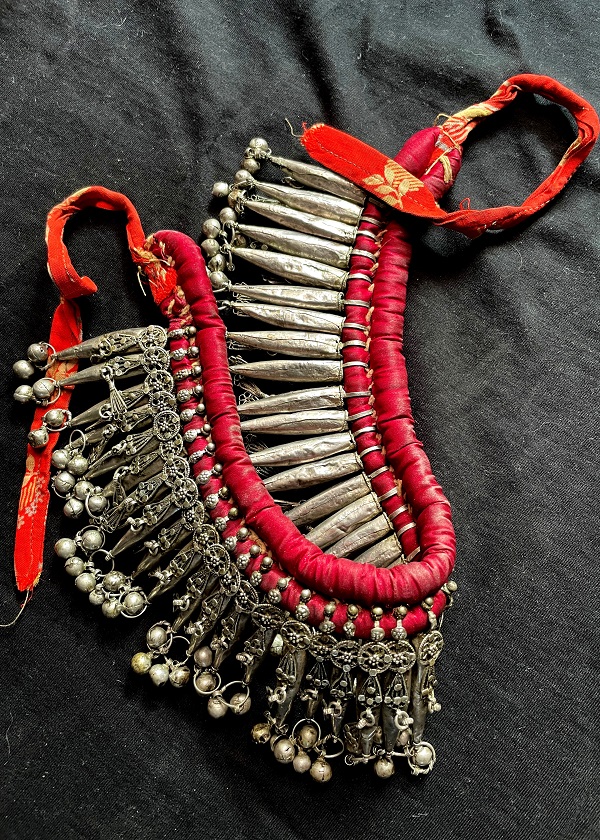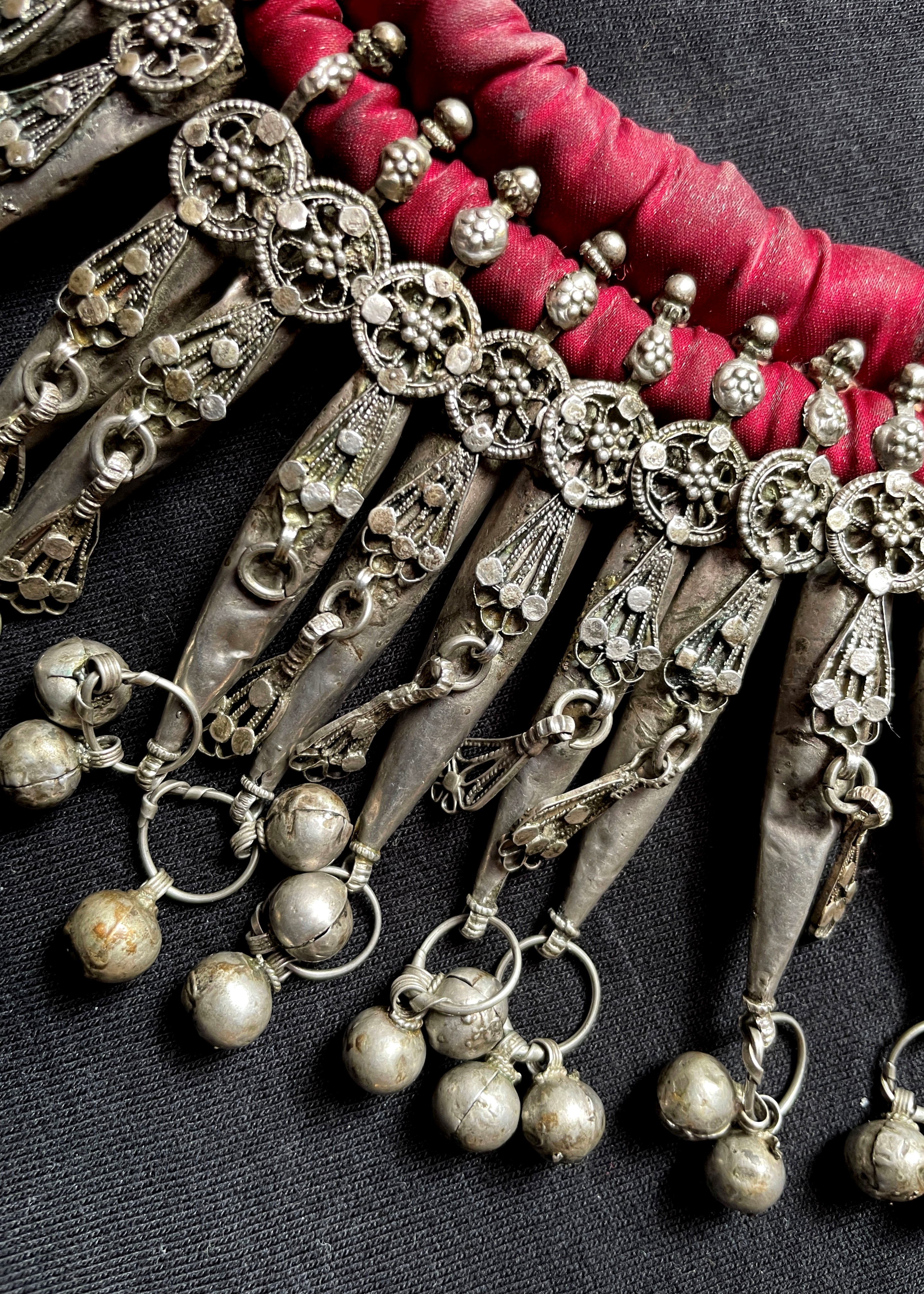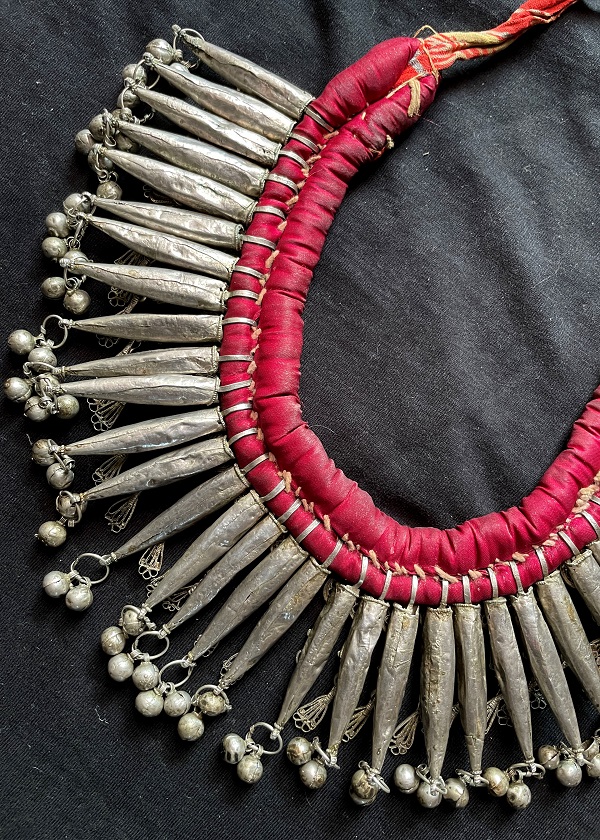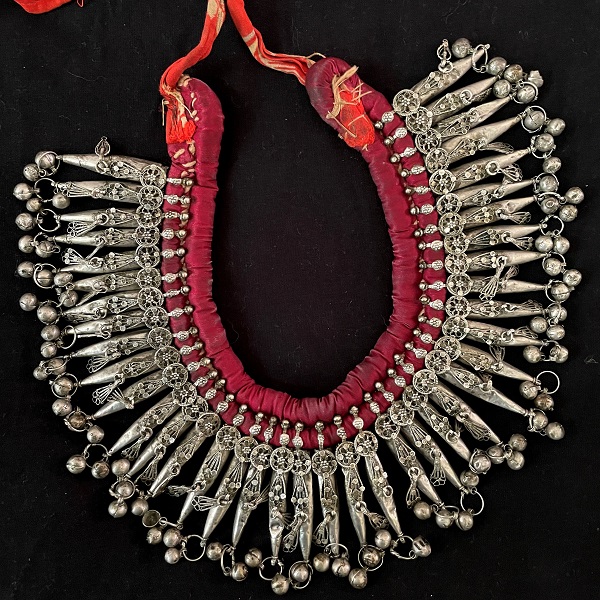Brid Beeler moved to Saudi Arabia in 1989 and stayed for a decade. Her career then led her to live and work in Yemen and Oman and work for some of the world’s top travel companies. She currently heads
Brid Beeler Travel Ltd and travels in and out of the region regularly. This is her first post in a series on her own jewellery collection. Her stories about her experiences in Saudi Arabia can be found
here.

The Souq
One of the joys of living and working in the Middle East over three decades was being able to visit the souqs on evenings or weekends. A particular favourite was the shop owned by Mohammad, one of the Yemeni silversmiths in the old city of Sana’a. I could spend hours in his cosy Aladdin’s cave, drinking tea and talking about jewellery. Other shoppers would stop in, have a few words, and move on.
Occasionally, a man would wander in with a plastic bag tightly knotted and wrapped around the hilt of his Jambīyah (Arabic: jamb: side), a traditional curved dagger, that Yemeni men wear tucked into their side or waist. Inside the bag would be items for sale. Someone had died in the family and, as silver jewellery was never passed on from mother to daughter, it was taken to the marketplace to be sold, broken apart, restrung, or perhaps melted down. ‘Recycling’ seems too harsh a word.

A Special Friendship
Sitting on a wooden stool in the corner, I would watch the comings and goings as I drank tea and listen to the conversations over pieces of jewellery. Sometimes, Mohammad would purchase a piece, most times, not. It could be midnight when I strolled through the city on my way home through the narrow streets of tall stone tower houses with their half-moon shaped
gumrīyah ( Arabic: Qamar: moon) windows of coloured glass for which Sana’a is famous. It was a very special place to live, and never did I feel unsafe as I walked those streets alone making my way homewards.
My jewellery collection expanded to a new level when I lived in Sana’a. I became hooked on the incredible array of jewellery designs and workmanship available in the marketplace. With interest, patience, and time, I learned from the jewellers. Many of the best pieces were never on display. They were hidden away in the recesses of the shop or safely kept at home.
From time to time, Mohammad would arrange to bring in a special piece for me to see, one that he knew would interest me as my knowledge, interest, and collection grew. With no pressure, it would be my choice to purchase or not. There was always another buyer; if not in Sana’a, then most definitely internationally as they worked with dealers all over the world. When I was considering a purchase, Mohammad would always say, “take it home, think about it, bring it back, no problem.” The hard bargaining came later. It was the way things were done and it endeared me to this friendship built up over the years.

A Special Treasure
On one such evening, I had arranged to drop in as Mohammad had a piece waiting for me to see. After the obligatory many glasses of tea and conversation over the topics of the day, the piece was brought forth for inspection. It was an old Sana’ani necklace made by Yahya Saleh and a little over 100 years old at the time of purchase.
It had a cartouche - a traditional stamp. Traditional silversmiths like Saleh did not have the capability of having their silver hallmarked, but they had a cartouche – a stamp that identified their craftsman and attested to the quality of their work. While I had seen similar pieces before, this one was exquisite. I simply had to have it.
Yahya Saleh's cartouche, identifying the silversmith's workmanship
The Wedding Necklace
The necklace Mohammad showed me that night is assembled on a double-woven padded band wrapped in a magenta silk fabric. There is mild wear on the cloth and strips of floral coloured cotton fabric have been added to each end to be tied around the back of the neck. The original ties had been worn through and replaced with another fabric. Not counting the ties, the necklace measures 41 cm long.
Forty silver pieces, each approximately 8 cm long, hang from the fabric band, attached using small hoops with a granulated accent. These silver pieces are hollow, shaped by hammering the sheet metal over a form. Each of the forty silver pieces is decorated with a filigree rosette at the top, a delicate filigree pendant at its midpoint and two small silver beads hanging from the end. The beads are hollow, having been formed in two halves which were then soldered together.
This piece was part of a wedding dowry and was worn at weddings. Although not present on this piece, such necklaces often would have a cloth backing to protect both the piece itself and the elaborate dress worn underneath. The silver workmanship of this necklace is exquisite and, more importantly, it has not been damaged or broken in any way.

Jewish Silversmiths
Yahya Saleh, the man who crafted this necklace, was a Jewish silversmith working in Sana’a in the first years of the twentieth century. He specialised in bridal jewellery. Several excellent examples of Yahya Saleh’s work can be seen in Marjorie Ransom’s book,
Silver Treasures from the Land of Sheba.
Most of the traditional silversmiths in the region were Jewish. The Jewish migration from Sana’a in 1949 and 1950 saw 49,000 Yemeni Jews airlifted on British and American planes to Israel in what was called Operation Magic Carpet. This resulted in a decline of silversmiths and a loss of much of the workmanship skills on the peninsula.
While Imam Ahmed, the last of the Zaydi imams, instructed the Jewish silversmiths to train Muslims in the craft before their departure, today most Muslim silversmiths are in their fifties and older. The younger generations, now seek third level education and are not interested in continuing in the craft. Silversmithing remains in the family tradition passed down from father to son within the artisan class, but it is sadly in decline as gold has become the jewellery of choice.
Hopefully, one day I will return to Yemen and once again drink tea with Mohammad in his shop and talk about jewellery. Who knows what treasure may await my return? If that is not to be, I have my memories and this magnificent necklace to remind me of Mohammad and those happy days in Sana’a.
**LIBAT MAZĀMĪR : (Arabic libah: the
suprasternal notch - the hollow area at the bottom of the neck where it reaches the chest, mizmār: flute, pl. mazāmīr), the name refers to where the necklace is worn on the neck and the shapes of silver that resemble flutes
Further Reading
Marjorie Ransom.
Silver Treasures from the Land of Sheba, American University in Cairo Press, 2014.
About the Author
In 2015, Brid Beeler managed the
Smithsonian Institution’s Sackler Gallery tour in Saudi Arabia, Oman and Qatar, which followed Saudi Arabia’s internationally acclaimed
Roads of Arabia exhibition. Brid facilitated the
History Channel’s Yemen documentary
Digging for the Truth – The Real Queen of Sheba. She also participated in the multi-level cultural project involving the Smithsonian and the Yemen and US governments that resulted in the publication of
Caravan Kingdoms: Yemen and the Ancient Incense Trade. With Crossing the Line Films, she facilitated logistics and key components for their award-winning documentary on the annual Qashqai migration in Iran, which was aired by
National Geographic under the title
Last Chance Journeys: Iran. Brid also consulted on a UNICEF, World Food Program project advocating for girls’ education in Yemen.
She has presented papers on eco-tourism in the region and was one of only a handful of women selected to speak at the first International Conference on Eco-Tourism in Saudi Arabia. Her other speaking engagements have included
The Ethnic Silver Jewelry of the Arabian Peninsula at the Chester Beatty Library in Dublin Castle. She currently contributes monthly to
aramcoexpats.com. Her collecting, which began in the souqs of Riyadh before extending to Yemen, Oman, and further afield, focuses on old silver jewellery, semi-precious stones, beadwork, and textiles from the Arabian Peninsula
*Copyright to all images belongs to Brid Beeler unless otherwise indicated. Reproduced here with permission.








